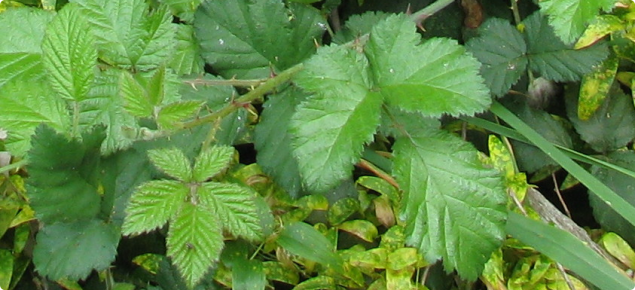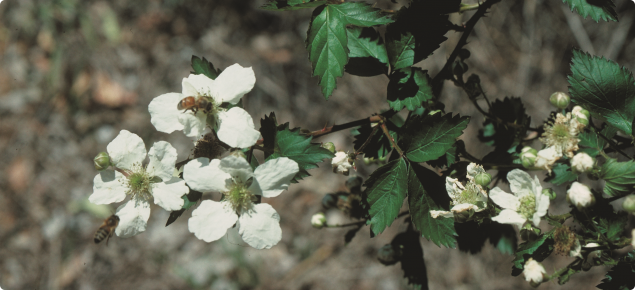Form: shrub — perennial
Status: present in WA
Native to Europe and adjacent areas. Blackberries have been prioritised at a national level as Weeds of National Significance (WoNS).
Appearance
Semi-deciduous scramblers to two metres high with canes up to seven metres long. Spread by seed, rooting of cane tips, and by suckers from lateral roots. The latter two means of spread result in large clumps over time. Fruit is eaten by birds and mammals (especially foxes) that may transport seeds some distance.
Stems: mostly arching, green, reddish or purple, ribbed lengthwise, with or without hairs. Plant covered with numerous prickles straight or curved, 3-12 millimetres long.
Leaves: usually comprise three or five leaflets with toothed margins, dark green on the upper surface and with many to no hairs underneath.
Flowers: to three centimetres wide with five white or pink petals. Flowers late spring to summer.
Fruit: globe-shaped, one to three centimetres across, initially green ripening through red to black, composed of numerous small juicy segments.
Seeds: pitted to three millimetres long.
Online weed identification training
Login or set up a new account on DPIRDs online training site to access:
- a training course on how to identify early blackberry and report it.
- training material that you can use to teach community groups how to identify early blackberry.
Agricultural and economic impact
Blackberry invades pastures, riverbanks and creeklines, forming dense thickets that harbour pests such as foxes and rabbits.
Declared pest category
The Western Australian Organism List (WAOL) contains information on the area(s) in which this pest is declared and the control and keeping categories to which it has been assigned in Western Australia (WA). Use the following WAOL link to reach the declaration and declaration map for: Rubus anglocandicans, Rubus laudatus, Rubus rugosus and Rubus ulmifolius.
Requirements for land owners/occupiers and other persons
Requirements for land owners/occupiers and other persons if this pest is found can be sourced through the declared plant requirements link.
Search > detect > report
| MyPestGuide™ Reporter | Pest and Disease Information Service (PaDIS) |
Detectability: medium difficulty to find. As its common name suggests, early blackberry (Rubus laudatus) flowers about a month earlier than other weedy blackberry species. Early blackberry can also be distinguished from other species because the leaves are green on both surfaces. The leaves of other weedy blackberries are green on the upper surface but white or whitish on the underside.
Who is likely to find it: landholders, biosecurity groups, natural resource management groups and others including the Harvey River Restoration Taskforce and Leschenault Catchment Council.
When to find it: early blackberry starts flowering in late spring, with white flowers noticeable by October. Other weedy blackberries start to flower in November/December.
Where to find it: early blackberry is most common in the Perth hills, and is also found from Perth to the south coast. Many infestations along the Brunswick and Collie rivers have been sprayed.
Control method
Control methods for this declared plant can be found through the blackberry control link.



